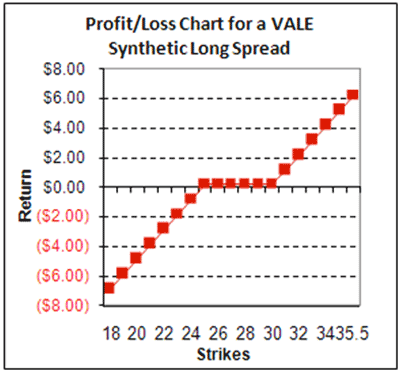Last week, Vale S.A. (VALE) confirmed reports that it will lower its average iron ore prices by 10% beginning in October. The stock pulled back following the news, but VALE shares have since rebounded from support in the $25-$26 region. The $26 area held last week, marking VALE's low on Wednesday, while the $25 level has held as long-term support since October 2009, with the stock closing only two weeks below this area during this time frame.
One trader appears to be betting on this technical support today by entering a split-strike synthetic long. This fancy version of a credit spread is established by purchasing an out-of-the-money call, the September 30 strike in this case, and selling an out-of-the-money put, the September 25 strike in the example. Specifically, the trader bought 6,714 September 30 calls for the ask price of $0.11, and sold 6,714 September 25 puts for the bid price of $0.28. The credit received for this trade was $0.17, or $17 per contract. That brings the total credit for the entire 6,714 contracts to $114,138.
Unlike a typical credit spread, where the profits and losses are limited, the split-strike synthetic long has an unlimited profit/loss risk profile. Since there is no limit to how high VALE can rally, potential returns are, theoretically, unlimited. Meanwhile, since there is no hedge to the sold September 25 put, losses are also viewed as "unlimited," though they are actually capped at the difference between the sold strike and the initial credit—or $2,483 per contract in this situation.
Below is a visual representation of the VALE split-strike synthetic long position:
By Joseph Hargett, contributor, Schaeffer’s Trading Floor Blog


















